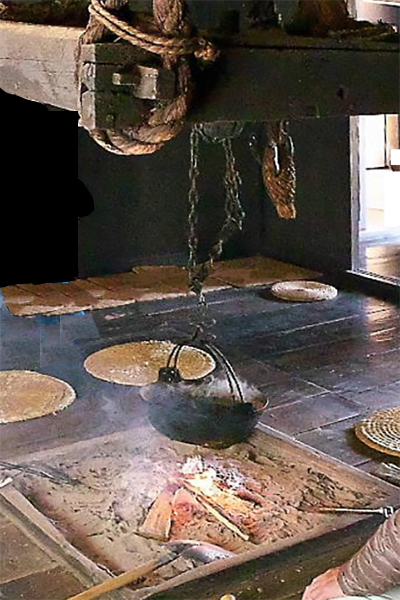

日本人が明治以降徐々にそのいごこち体験から遠ざかってきた囲炉裏。
日常生活でこの囲炉裏から別離したのは、最終的には戦後なのかも知れない。
逆に言うと離れてからまだ60-70年くらいの時間しか経過していない。
それ以前には採暖・調理はすなわち囲炉裏というのが常識だったのだ。
朝鮮半島や北東アジア地域ではオンドルという床暖房装置があった。
ロシアには暖炉という暖房もあったけれど、日本には存在しなかった。
囲炉裏というのは室内気候を調整する「暖房」ではなく
カラダそのものに輻射的に熱を当てる「採暖」装置なのですね。
火が当たる前面は灼熱、背中側は極寒という非暖房的熱環境。
幕末に至ってロシアとの間で蝦夷地で緊張が高まったので
東北各藩から国土防衛のために武士の一団が派遣駐留したが、
戦闘でではなく、冬の寒さからの健康被害でかれらの多くが頓死した。
とにかく日本社会は囲炉裏装置の1本足対策で冬に立ち向かっていた。
こういった熱環境体験記憶というのは人間にどのように影響するのか、
言ってみれば「建築環境心理学」みたいな領域って、
どういった研究があるのか、寡聞にして聞かない。
たぶん相当に決定的影響があるだろう割には研究がされていない。
家族関係論ということを想定してみても、
この囲炉裏空間と脱・囲炉裏空間で家族の「団欒交流」がどう変化したか?
今日の「高断熱高気密化」でのその精神性部分の変化も併せ、
温熱環境が家族関係に及ぼす影響について、研究を知りたいと思う。
もし研究が進むとすれば高断熱高気密住宅が普及して一定の時間が経過した
北海道が先鞭を付けるべきだろうと思う。
いま現在ならばまだ、体験記憶と空間環境の実証データ化が可能だし、
それがテコと機能してそれ以前の囲炉裏環境でのデータ化も可能ではないか。

そのような科学的アプローチが少ない中では
弊誌Replan連載の東大・前真之准教授のいくつかの論考がある。
輻射熱の作用について、アプローチされていて興味を強くそそられた。
いま見聞きできることは情緒的な「家族団欒」体験記憶。
たまに建築研究の立場から学生さんがこういう輻射環境を体験するけれど、
数日で耐えられなくなってしまうのだという。過激な温度差。
多くの体験談を総合すると、囲炉裏を囲んでの家族団欒にはみなノスタルジーを
持っているようだけれど、しかしそれはあくまでも夢想領域であり
現代の住宅建築で囲炉裏の設置を求めてはいない。
このことの方が建築環境心理学としてもはるかに重大なことでしょう。
言い換えると、採暖に留まって暖房開発に向かわなかったことの分析の方が
より日本人の精神性理解にとっては重要だと思われますね。
このあたりは黒船で一気に鎖国から開国維新を成し遂げ、
やがて先進国家に変貌していった歴史経緯とも似通っていると思う。
国内での自己変革は苦手で固陋だけれど外圧を利用しての革新は得意みたいな。
考えてみると北海道は開拓手法自体も欧米思想を輸入して、
その合理主義があって採暖から暖房へと意識変革が進んだのかも知れない。
北海道開拓そのものが「外圧」を象徴することだったのかも。
English version⬇
[Nostalgic but no hope of restoration Hearth / Good Japanese house ㉚-5]
The hearth where the Japanese have gradually moved away from the experience of being comfortable since the Meiji era.
It may be after the war that he separated from this hearth in his daily life.
To put it the other way around, only about 60-70 years have passed since I left.
Before that, it was common sense that heating and cooking was a hearth.
In the Korean Peninsula and Northeast Asia, there was a floor heating system called Ondol.
There was a fireplace in Russia, but it didn’t exist in Japan.
The hearth is not “heating” that regulates the indoor climate
It’s a “warming” device that radiantly heats the body itself, isn’t it?
A non-heating thermal environment where the front is scorching and the back is extremely cold.
At the end of the Tokugawa shogunate, tensions with Russia increased in Ezo.
A group of samurai were dispatched from each Tohoku clan to defend the land,
Many of them died not in combat but in the health hazards of the cold winter.
Anyway, Japanese society was confronting winter with one-legged measures for the hearth device.
How does this kind of thermal environment experience memory affect humans?
So to speak, an area like “building environmental psychology”
I don’t ask what kind of research there is.
It has not been studied, although it probably has a considerable “decisive effect”.
Even assuming that it is a family relationship theory,
How did the family’s “group exchange” change between this hearth space and the de-hearth space?
In addition to the changes in that part due to today’s “high heat insulation and high airtightness”,
I would like to know about the effects of the thermal environment on family relationships.
If research progresses, a certain amount of time has passed since highly insulated and airtight houses became widespread.
I think Hokkaido should take the lead.
At present, it is still possible to convert experience memory and spatial environment into empirical data.
Isn’t it possible that it works with leverage and can be converted into data in the hearth environment before that?
While there are few such scientific approaches
There are some articles by Associate Professor Masayuki Mae of the University of Tokyo serialized in our magazine Replan.
The action of radiant heat was approached and intrigued.
Most of the reactions that can be seen and heard now are the memories of the “family unity” experience in the emotional part.
Sometimes students experience this kind of radiant environment from the standpoint of architectural research,
It will be unbearable in a few days. Extreme temperature difference space.
Summarizing many experiences, nostalgia for family unity around the hearth
It seems to have it uniformly, but it is just a dream area
Modern residential construction does not require a re-experience of the hearth.
This would be far more important in architectural psychology.
In other words, the analysis of staying warm and not going to heating development is better.
It seems to be more important for Japanese understanding of spirituality.
In this area, Kurofune achieved the opening of the country from isolation at once,
I think it is similar to the history of the transformation into a developed country.
He is not good at self-transformation in Japan and is strong, but he seems to be good at innovation using external pressure.
When you think about it, Hokkaido imports Western ideas from the pioneering method itself,
That rationalism may have led to a change in consciousness from heating to heating.
The development of Hokkaido itself may have been a symbol of “external pressure.”
Posted on 5月 15th, 2021 by 三木 奎吾
Filed under: 住宅マーケティング, 日本社会・文化研究







コメントを投稿
「※誹謗中傷や、悪意のある書き込み、営利目的などのコメントを防ぐために、投稿された全てのコメントは一時的に保留されますのでご了承ください。」
You must be logged in to post a comment.